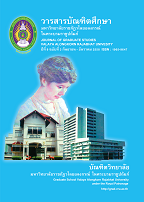การพัฒนารูปแบบการเรียนการสอนอ่านเพื่อความเข้าใจ ผ่านเครือข่ายอินเทอร์เน็ต กลุ่มสาระการเรียนรู้ภาษาไทย สำหรับนักเรียนชั้นมัธยมศึกษาปีที่ 3 THE DEVELOPMENT OF AN INSTRUCTIONAL MODEL ON READING COMPREHENSION OF THAI LANGUAGE SUBJECT GROUP THROUGH INTERNET NE
Main Article Content
Abstract
บทคัดย่อ
การวิจัยครั้งนี้มีวัตถุประสงค์เพื่อ (1) ศึกษาปัจจัยนำเข้าและกระบวนการที่เกี่ยวข้องกับการจัดการเรียนการสอนอ่านเพื่อความเข้าใจผ่านเครือข่ายอินเทอร์เน็ต กลุ่มสาระการเรียนรู้ภาษาไทย สำหรับนักเรียนชั้นมัธยมศึกษาปีที่ 3 (2) พัฒนารูปแบบการเรียนการสอนอ่านเพื่อความเข้าใจ ผ่านเครือข่ายอินเทอร์เน็ต กลุ่มสาระการเรียนรู้ภาษาไทย สำหรับนักเรียนชั้นมัธยมศึกษาปีที่ 3 (3) ศึกษาประสิทธิผลของรูปแบบการเรียนการสอนอ่านเพื่อความเข้าใจ ผ่านเครือข่ายอินเทอร์เน็ต ในด้านผลสัมฤทธิ์ทางการเรียน ความคงทนในการเรียนรู้ และความพึงพอใจของนักเรียน การวิจัยดำเนินการตามขั้นตอนการวิจัยและพัฒนา (Research and Development) เป็น 3 ระยะคือ ระยะที่ 1 การศึกษาปัจจัยนำเข้า และกระบวนการที่เกี่ยวข้อง กับการจัดการเรียนการสอนอ่าน เพื่อความเข้าใจ ผ่านเครือข่ายอินเทอร์เน็ต เพื่อกำหนดกรอบแนวคิด สร้างต้นร่างรูปแบบการเรียนการสอน และนำมาสร้างบทเรียนที่เรียนโดยผ่านเครือข่ายอินเทอร์เน็ตตามหลักการออกแบบของ ADDIE Model ระยะที่ 2 การพัฒนารูปแบบการเรียนการสอนอ่านเพื่อความเข้าใจ ผ่านเครือข่ายอินเทอร์เน็ต กลุ่มสาระการเรียนรู้ภาษาไทย สำหรับนักเรียนชั้นมัธยมศึกษาปีที่ 3 ระยะที่ 3 การศึกษาประสิทธิผลของรูปแบบการเรียนการสอนในด้านผลสัมฤทธิ์ทางการเรียน ความคงทนในการเรียนรู้ และความพึงพอใจของนักเรียน
กลุ่มตัวอย่างที่ใช้ในการศึกษา ได้แก่ นักเรียนชั้นมัธยมศึกษาปีที่ 3 จำนวน 22 คน จากโรงเรียนบ้านพรหมนิมิต สำนักงานเขตพื้นที่การศึกษาประถมศึกษาสระแก้ว เขต 1 โดยการสุ่มแบบแบ่งชั้น และสุ่มอย่างง่าย โดยการจับฉลาก เพื่อเรียนด้วยบทเรียนผ่านเครือข่ายอินเทอร์เน็ต ซึ่งพัฒนาตามเกณฑ์ประสิทธิภาพ 80/80 วิเคราะห์ข้อมูล โดยคำนวณค่าร้อยละ ค่าเฉลี่ย ส่วนเบี่ยงเบนมาตรฐาน และการทดสอบค่าที (t-test Dependent)
ผลการวิจัยพบว่า
1. ผลการศึกษาปัจจัยนำเข้า และกระบวนการที่เกี่ยวข้องกับการจัดการเรียนการสอนอ่านเพื่อความเข้าใจเพื่อนำมากำหนดกรอบแนวคิดสร้างต้นร่างรูปแบบการเรียนการสอน และสร้างบทเรียนผ่านเครือข่ายอินเทอร์เน็ต ประกอบด้วยข้อมูล 5 ส่วน ได้แก่ (1) แนวคิด ทฤษฎี และงานวิจัยที่เกี่ยวกับการพัฒนารูปแบบการเรียนการสอน (2) ข้อมูลเกี่ยวกับหลักสูตร และกิจกรรมการเรียนการสอน กลุ่มสาระการเรียนรู้ภาษาไทย การจัดการเรียนการสอนภาษาไทยในระดับชั้นมัธยมศึกษาปีที่ 3 (3) แนวคิด ทฤษฎี หลักการ งานวิจัยที่เกี่ยวกับการอ่านเพื่อความเข้าใจ กลวิธี เทคนิคการสอนอ่าน และสภาพปัญหาอุปสรรคในการจัดการเรียน การสอนอ่านเพื่อความเข้าใจ (4) ข้อมูลเกี่ยวกับแนวคิด ทฤษฎีการจัดการเรียนการสอน และการออกแบบบทเรียน ผ่านเครือข่ายอินเทอร์เน็ต (5) แนวคิด ทฤษฎีการเรียนรู้
2. ผลการพัฒนารูปแบบการเรียนการสอนอ่านเพื่อความเข้าใจ ผ่านเครือข่ายอินเทอร์เน็ตมีองค์ประกอบสำคัญ 4 ประการคือ หลักการ จุดมุ่งหมาย ขั้นตอนการจัดการเรียนการสอนผ่านเครือข่าย และการวัดประเมินผล ลักษณะเฉพาะของกระบวนการเรียนการสอนเน้นการสอนตรง การสอนทางอ้อม การสอนแบบสอดแทรก และกลวิธีการเรียนรู้ และเข้าใจตนเอง (Meta Cognition) ซึ่งผ่านการประเมินจากผู้เชี่ยวชาญอยู่ในเกณฑ์เหมาะสมมาก กระบวนการเรียนการสอนมี 3 ขั้นตอนคือ (1) ขั้นเตรียมความพร้อมก่อนเรียนมีกิจกรรมย่อยคือ การเตรียมความพร้อมผู้เรียน การกระตุ้นความรู้เดิม และการวางแผนการเรียน (2) ขั้นระหว่างการเรียนตามรูปแบบ มีกิจกรรมย่อยคือ ขั้นนำเข้าสู่บทเรียน, ขั้นตอนการสอน/เสนอเนื้อหา ขั้นให้ผลย้อนกลับและเสริมแรง และขั้นประเมินกิจกรรมของแต่ละบทเรียน 3) ขั้นกิจกรรมหลังการเรียนมีกิจกรรมย่อยคือ ทดสอบการอ่านเพื่อความเข้าใจ ตรวจสอบผลการเรียนและกิจกรรมเสริมทักษะความสามารถด้านการอ่าน เพื่อความเข้าใจ ซึ่งผ่านการประเมินจากผู้เชี่ยวชาญอยู่ในเกณฑ์เหมาะสมมาก ประสิทธิภาพของบทเรียนผ่านเครือข่ายอินเทอร์เน็ต ที่พัฒนาขึ้นมีประสิทธิภาพ (E1/E2) 82.79/82.93 เป็นไปตามเกณฑ์ที่กำหนด ส่วนของการออกแบบบทเรียนผ่านเครือข่ายอินเทอร์เน็ตได้ประยุกต์ตามหลักการออกแบบของ ADDIE Model ประกอบด้วยขั้นตอน 5 ขั้น ได้แก่ ขั้นที่ 1 การวิเคราะห์เนื้อหา (Content Analysis) ขั้นที่ 2 การออกแบบบทเรียน (Design) ขั้นที่ 3 การจัดกรอบเนื้อหาบทเรียน (Development) ขั้นที่ 4 การพัฒนาและทดลองบทเรียนออนไลน์ (Implementation) ขั้นที่ 5 การตรวจสอบคุณภาพบทเรียนที่พัฒนาขึ้น (Quality Evaluation) โดยผู้เชี่ยวชาญด้านเนื้อหาและการผลิตสื่อ
3. ผลการศึกษาประสิทธิผลของรูปแบบการเรียนการสอนอ่านเพื่อความเข้าใจ ผ่านเครือข่าย อินเทอร์เน็ต ในด้านผลสัมฤทธิ์ทางการเรียน ความคงทนในการเรียน และความพึงพอใจของนักเรียน พบว่า (1) ผลสัมฤทธิ์ทางการเรียนหลังเรียนของกลุ่มตัวอย่าง สูงกว่าคะแนนก่อนเรียนอย่างมีนัยสำคัญทางสถิติที่ระดับ.05 (2) กลุ่มตัวอย่างที่เรียนด้วยรูปแบบการเรียนการสอนอ่านเพื่อความเข้าใจ ผ่านเครือข่ายอินเทอร์เน็ต มีความคงทนในการเรียนรู้ไม่แตกต่างกัน (3) กลุ่มตัวอย่างที่เรียนด้วยรูปแบบการเรียนการสอนอ่าน เพื่อความเข้าใจ ผ่านเครือข่ายอินเทอร์เน็ต กลุ่มสาระการเรียนรู้ภาษาไทย มีความพึงพอใจอยู่ในระดับมาก
ABSTRACT
The purposes of this research were 1) to study the input and process related to the management of teaching and learning on reading comprehension of Thai language subject group through internet network for mathayomsuksa 3 students, 2) to develop an instructional model on reading comprehension of Thai language subject group through internet network for mathayomsuksa 3 students, and 3) to study the effectiveness of an instructional model on reading comprehension of Thai language subject group through internet network in terms of achievement, learning retention and level of satisfaction.
The research was divided into 3 phases. Phase 1: studying of the input and process were conducted in order to devise an instructional framework of the instructional model on reading comprehension of Thai language subject group through internet network. Phase 2: the instructional model on reading comprehension of Thai language subject group through internet network for mathayomsuksa 3 students was conducted. Phase 3: the effectiveness of the instructional model on reading comprehension of Thai language subject group through internet network for mathayomsuksa 3 students was done in terms of achievement, learning retention and level satisfaction.
The sample in this study included twenty-two mathayomsuksa 3 students of Banphomnimit school in Sakaeo primary educational service area 1, obtained by the stratified random sampling and simple random sampling. The sample studied reading comprehension of Thai language subject group through internet network with the standard criterion of 80/80. The instruments were an achievement test, class exercises, behavioral observation and satisfaction assessment. The data were analyzed by using percentage, mean, standard deviation and t-test (dependent).
The research findings were as follows:
1. The results of the study of the input and process related to teaching, reading comprehension used to create the lesson of Thai language subject group through internet network for mathayomsuksa 3 students consisted of five parts as follows: 1) the data of concept, theory and research to the development of the instructional model, 2) the data of curriculum and instruction of Thai language subject group and activities for teaching Thai languages for mathayomsuksa 3 students, 3) the data of concept, theory and research related to reading comprehension, strategies and techniques for teaching, reading comprehension, problems and difficulties in teaching and learning, 4) the data of theories of teaching, learning and design lessons through internet network and 5) the data of learning theories.
2. The results of the development of the instructional model on reading comprehension of Thai language subject group through internet network for mathayomsuksa 3 students consisted of four components: principle, objectives, instructional process and evaluation. The instructional process specifically focused on direct approach, indirect approach and meta cognition. The three steps of instructional process were: 1) preparation before learning, the activities consisted of preparing learners, stimulating prior knowledge and planning to learn, 2) preparation during learning of the model, the activities consisted of introduction, teaching the content or presentation the content, feedback and stimulating and evaluated activities of the unit, 3) post- learning activities consisted of evaluation reading comprehension, checking achievements and practicing reading comprehension skill. The five steps of the lesson through internet network applied to ADDIE model were: 1) Content analysis 2) Design 3) Development 4) Implementation and 5) Evaluation. The assessment of the lesson evaluated from the experts was at the appropriate level and the effectiveness of the lesson through internet network met the standard criterion of (E1/E2) 82.79/82.93.
3. The results of the study of the effectiveness of the instructional model on reading comprehension of Thai language subject group through internet network in achievement, learning retention and level satisfaction were as follows : 1) the post-test scores of the sample were significantly higher than those of the pre-test at the level of .05, 2) there was no significant difference in learning retention of the sample studying from the instructional model on reading comprehension of Thai language subject group through internet network and 3) the sample studying from the instructional model on reading comprehension of Thai language subject group through internet network had a high level of satisfaction.
Article Details
บทความทุกเรื่องได้รับการตรวจความถูกต้องทางวิชาการโดยผู้ทรงคุณวุฒิ ทรรศนะและข้อคิดเห็นในบทความวารสารบัณฑิตศึกษา มหาวิทยาลัยราชภัฏวไลยอลงกรณ์ ในพระบรมราชูปถัมภ์ มิใช่เป็นทรรศนะและความคิดของผู้จัดทำจึงมิใช่ความรับผิดชอบของบัณฑิตวิทยาลัย มหาวิทยาลัยราชภัฏวไลยอลงกรณ์ ในพระบรมราชูปถัมภ์ กองบรรณาธิการไม่สงวนสิทธิ์การคัดลอก แต่ให้อ้างอิงแหล่งที่มา


